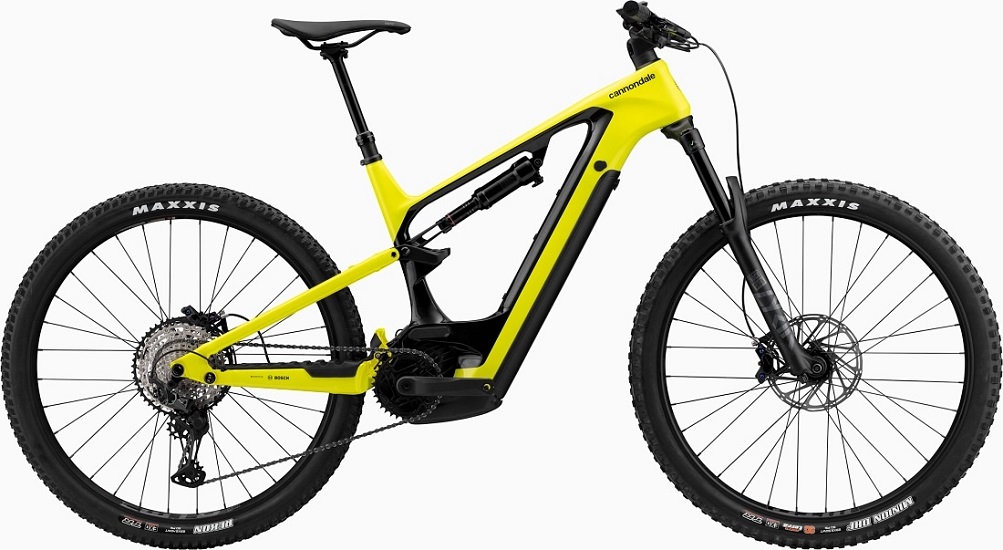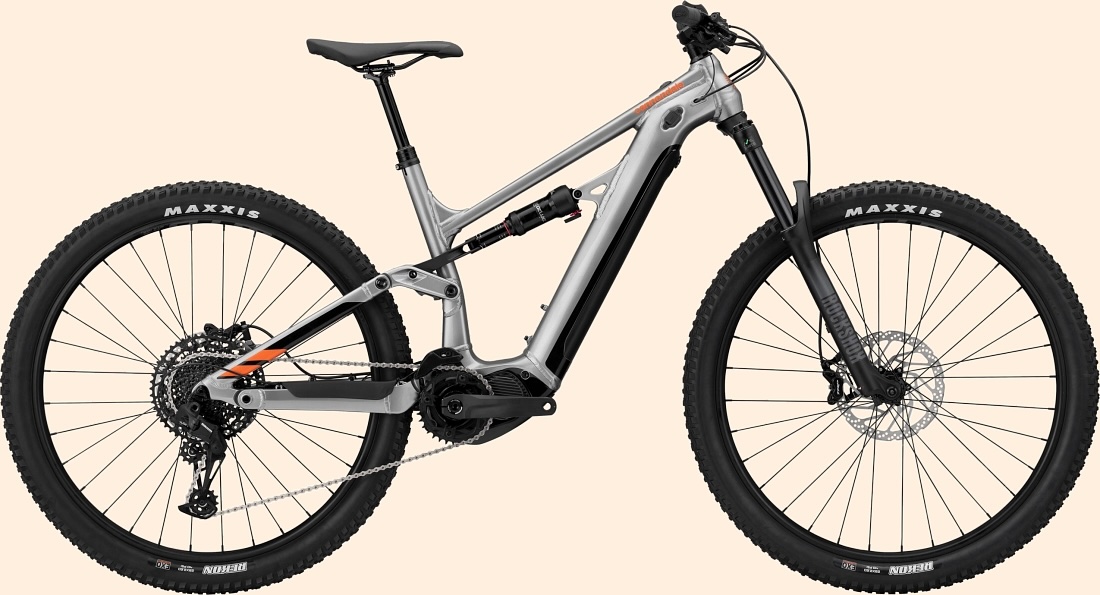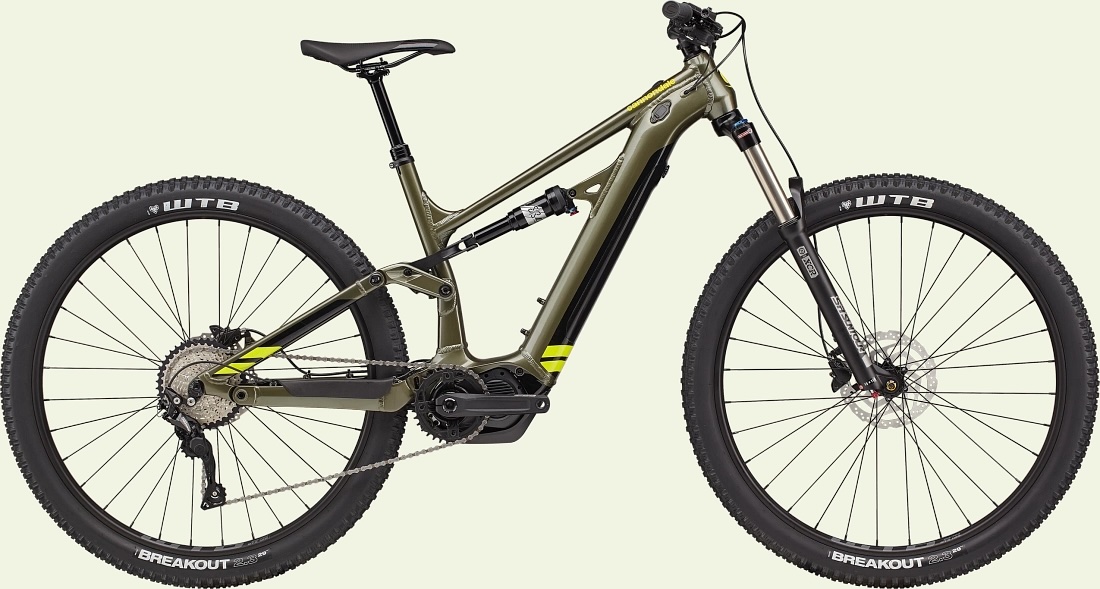Cannondale Moterra eMTB Spec Review, 2024

The Cannondale Moterra is built around 29-in. wheels and 150mm of suspension, front and rear and a 250W mid-drive motor. This is a Class 1 eMTB with a maximum assist speed of 20 mph, which is to say, it will be legal anywhere e-bikes are permitted.
Cannondale numbers the Moterra variants 1-5, with the 1 being the priciest (nearly $8500 at retail) and the 5 being the most affordable (less than $5000 at retail). The five eMTBs feature plenty of differentiation, making each price point a great balance of value and features.
There are plenty of interesting details; let’s have a look.
Cannondale Moterra Spec Review: Bike Overview
Let’s begin by taking a look at all the features that each of the Cannondale Moterra editions share. They all come available in four sizes. They all roll on 29-in. wheels, except for the small sizes in the 3 and 5, which receive the mullet treatment with a 29-in. wheel front and 27.5-in. wheel rear. Each is built with a 250W mid-drive motor, though whose motor varies some. And they all come with a dropper post.
Similarities and themes run through the product line, but each edition responds to the value proposition a little differently.
Cannondale Moterra Review: Specs & Features
Frame and fork
The Cannondale Moterra 1 and 2 are built from carbon fiber to give the eMTB the best ratio of stiffness to weight and strength. The 3, 4 and 5 are all built from 6000-series aluminum, something Cannondale has been an expert in since their first bikes back in the 1980s. Cannondale pioneered the heat treatment of bikes made from 6000-series aluminum.
The Moterra 1-4 all use a version of the RockShox Select shock in the rear, while the 5 sports a more affordable X-Fusion 02 Pro.
RockShox forks are spec’d on the Moterra 1-4; the Lyrik fork is spec’d on the 1 and 2. The 3 gets the Yari and the 4 gets the 35 Silver. The 5 gets the SR Suntour XCR LO, which only has 140mm of travel. The SR Suntour is a noticeable downgrade from the RockShox forks found on the other editions.
With four sizes to choose from Cannondale says that they can accommodate riders from 5 feet 1 all the way up to 6 feet 5, which seems reasonable.
In terms of geometry, the Cannondale Moterra is made to give riders great stability on fast descents while still offering agile turning on tight singletrack. The frame design is such that the rider enjoys a position over the pedals that makes pedaling easy. The seat angle is such that as the seat is raised or lowered, the reach to the bar will increase or decrease in a way that helps fit.
Motor and battery
As we mentioned in our opening, The Cannondale Moterra is a Class 1 eMTB with a maximum assist speed of 20 mph. Each version of the Moterra is equipped with a 250W mid-drive motor. What changes between the various editions is just which motor is spec’d.
The Cannondale Moterra 1, 2 and 3 all receive the Bosch Performance Line CX motor, one of the more popular motors on eMTBs. This motor produces 85Nm of torque to give riders the power for climbing steep terrain. The Moterra 4 gets the Shimano EP8 (85Nm torque), while the Moterra 5 comes with the Shimano E7000 motor (60Nm torque).
Naturally, battery size varies with each edition. The Moterra 1, 2 and 3 are powered by Bosch’s 750Wh PowerTube. The Moterra 4 comes with a 630Wh Shimano battery, while the Moterra 5 gets a 504Wh battery.
The Bosch-equipped models all enjoy certification to UL’s 2849 standard, governing the entire system, including motor and battery. The two Shimano-equipped versions aren’t yet UL-certified (it’s coming), but they are certified to the EU’s 15194 standard.
Componentry
It’s in cockpit components: handlebar, saddle, stem and seatpost that we often see examples of companies working hard to bring down the cost of an e-bike as they move from the most expensive version to the most affordable version. The Cannondale Moterra is no different.
With the Cannondale Moterra 1, we see a carbon fiber handlebar, but on the other four models, they all receive an alloy bar.
All five of the Moterras receive a dropper post and the amount of adjustability varies depending on the size of frame. The smaller sizes getting less range and the bigger sizes covering more.
Drivetrain, brakes and wheels
For an eMTB to meet the sort of performance riders expect, it really can’t afford to trip where the motor, battery, suspension, brakes or drivetrain are concerned. A weakness in any of those areas will hamper an eMTB’s performance.
The Cannondale Moterra comes with a 12-speed drivetrain on the 1, 2 3 and 4. The Moterra 5 comes with a 10-speed drivetrain, which results in a narrower range of gearing.
The Moterra 1, 2 and 3 see a mix of Shimano parts: XTR and Deore XT on the 1, Deore XT and SLX on the 2 and Deore XT and Deore on the 3. The Monterra 4 comes with SRAM NX Eagle parts. While the Monterra 1, 2 and 3 all feature a super-wide-range 10-51t cassette (510 percent range), the SRAM-equipped 4 sports an 11-50 cassette. The Monterra 5 comes with a 10-speed Deore group. We presume they chose this group for improved durability. However, it does come with a notably narrower range of gears (11-42t, which means a roughly 380 percent range).
Practically speaking, riders across most of the U.S. won’t miss that 51t cog in back because the terrain simply isn’t steep enough or long enough to require it.
The Cannondale Moterra 1, 2, 3 and 4 all come with 4-piston hydraulic brakes. They range from near-top-of-the-line Deore XT on the 1 down to TRP brakes on the 4. All are paired with 203 or 200mm rotors. The Moterra 5 receives more traditional 2-piston stoppers with 180mm rotors, another signal that this eMTB may be primarily aimed at riders living in flatter locales.
The wheels all feature 32 spokes and alloy rims, with hubs that use thru-axles (15 x 110mm front, 12 x 148mm rear). As we move up the line from least expensive to most expensive, bearing quality improves and weight goes down without sacrificing strength.
While the Moterra 1, 2 3 and 4 all come with 29 x 2.6-in.-wide tubeless-ready tires, the Moterra 5 comes with 29 x 2.3-in.-wide tires.
EBR’s Cannondale Moterra First Look Review:
The Cannondale Moterra is a terrific example of how a bike company will come up with a great design and then ask themselves just how many different price points they can offer it at. While there’s never any doubt that the top-of-the-line model rocks, the sweet spot in value is often a rung or two down from the top.
Such is the case with the Cannondale Moterra 2. Thanks to its carbon fiber frame, Bosch Performance Line CX motor, mix of Shimano Deore XT and SLX parts and RockShox fork and shock, it is an impressive eMTB.
Buyers who find the Moterra 2 out of reach may find the Moterra 4 to be their sweet spot. By switching to an alloy frame, Cannondale shaves off some cost. The Shimano EP8 motor is well-reviewed against the Bosch motor and its SRAM NX Eagle drivetrain offers terrific performance for its cost. While it gives up some range (630Wh battery instead of the 750Wh Bosch PowerTube), a rider will still enjoy long rides on the Moterra 4 (Cannondale estimates up to 75 mi. per charge), but maybe not spend the whole day in Turbo.
The Moterra 5 suffers some weaknesses relative to the other versions. It’s motor isn’t as powerful and its battery is smaller, plus the drivetrain features fewer gears and a narrower range of gears, plus, the brakes aren’t as powerful. Those are only weaknesses when we compare it to more expensive versions of the Moterra, though. The Cannondale Moterra 5 shaves off more than $1000 from the Moterra 4. That difference in price may be the difference between purchasing an eMTB vs. an all-terrain e-bike. Riders save money on the front end, but enjoy the same frame found in the Moterra 3 and 4. Riders can always make upgrades later.
No matter what the buyer’s budget is, Cannondale has done an impressive job with the Moterra. This is a versatile eMTB that would be at home in the mountains of the Pacific Northwest or the rolling hills of Wisconsin’s Door Country.
While some brands suffer from spotty dealer locations, Cannondale has a vast dealer network across the country. That not only improves availability, it also means its easier to get service at home or on vacation. Indeed, with REI carrying them now, buyers will enjoy solid backing for an eMTB fun enough to want to squeeze the last watt/hour from the battery.





